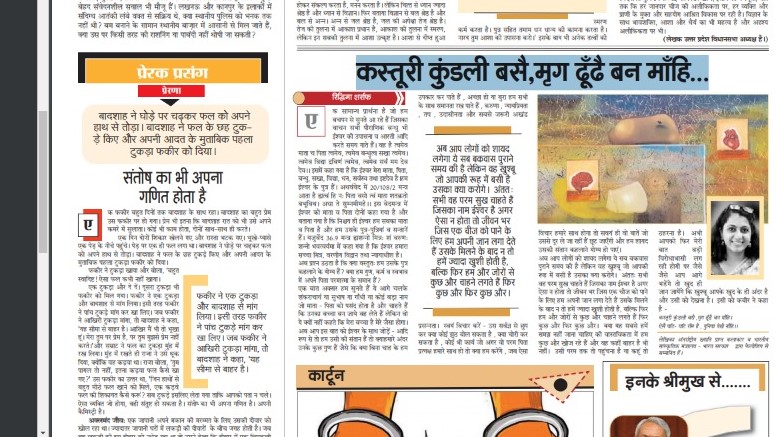यह भागवत पुराण पुस्तक संक्षिप्त रूप में रिद्धिमा सर्राफ़ द्वारा पद्यात्मक रुप में लिखी गयी है। लेखिका ने स्वांतः सुखाय के लिए, अपनी टूटी-फूटी भाषा में अपने प्रभु का यश गाकर उन्हें ही रिझाने का प्रयास किया है और उसे भी यह ईश्वर का प्रशाद ही मानतीं हैं। #भागवतपुराण #रिद्धिमा #selfhelp #आध्यात्म #सनातन #RiddhimaSarraf #bookreader #religious #Bhagvatpuran
Category: paintings
all paintings are on sale.
Moksha Geeta

Connection of Art, Science & Life
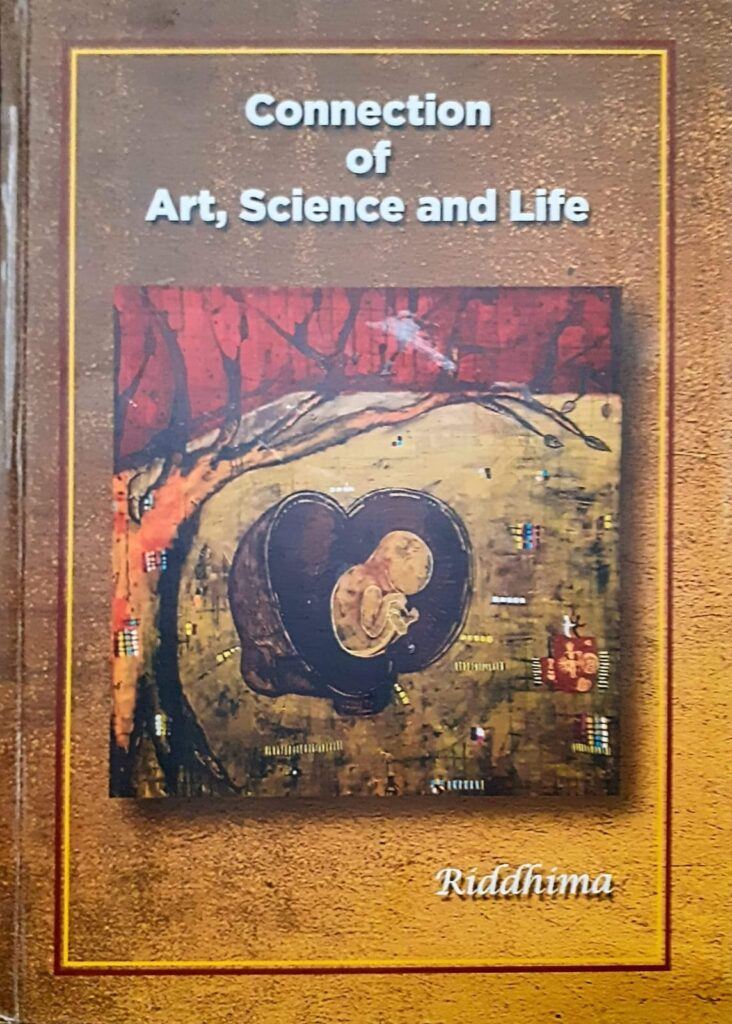
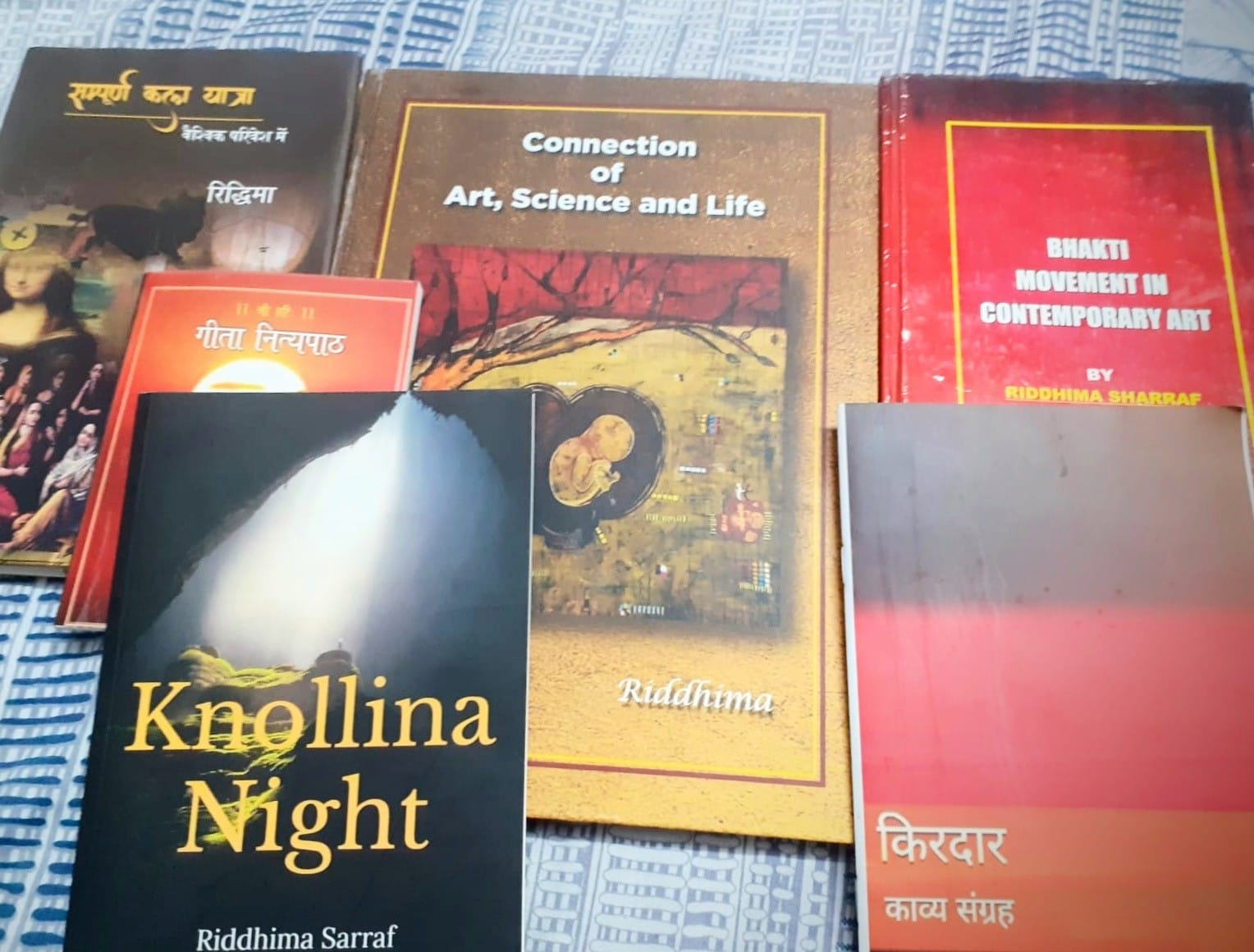
Book Launch
Sampoorn Kala Yatra
सम्पूर्ण कला यात्रा/
वैश्विक परिवेश में
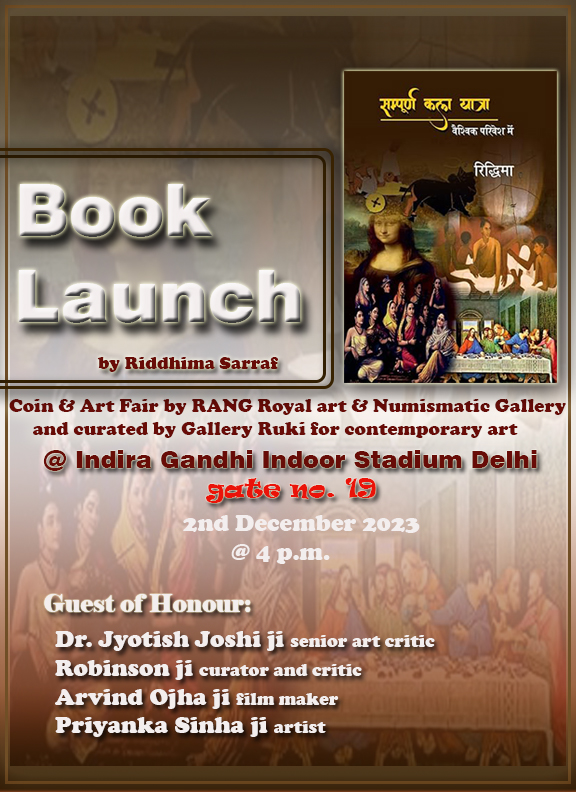
“Transcend Boundaries”
‘ Art ! Science ! Life ! ,
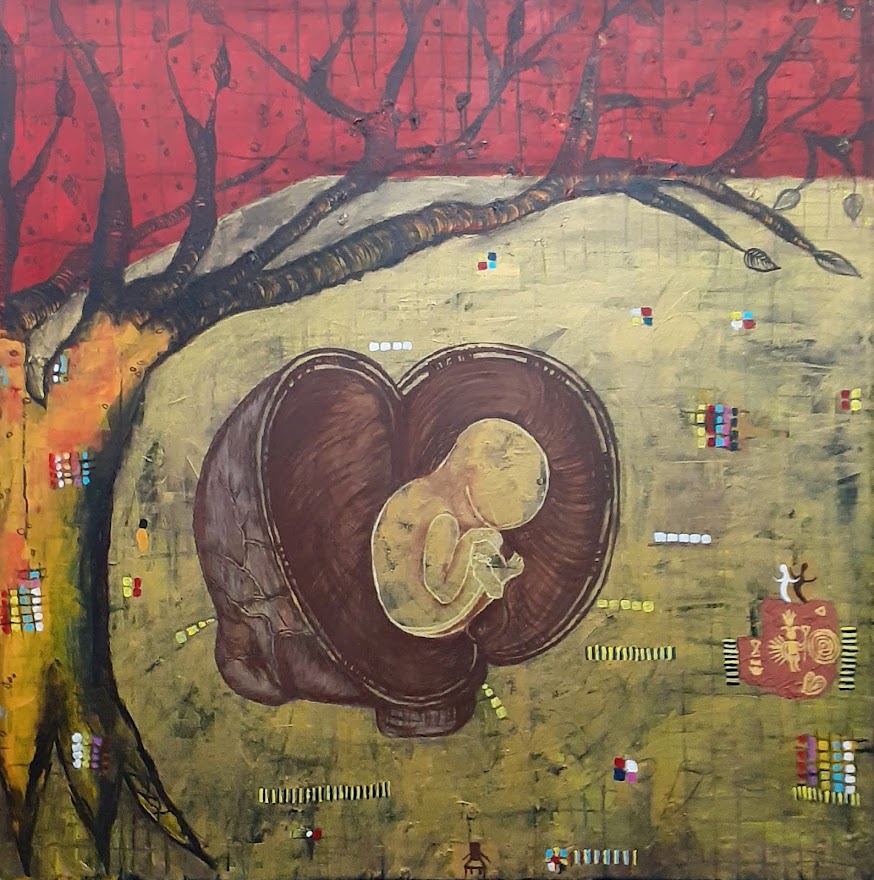
Scientific Mind:
Our personality is in a way an extension of our mind, the thoughts, notions and perceptions it carries. Many faces are shown here viewing which any person can know their personality to such an extent that he can understand their mind, that’s why the main character’s face is depicted in the picture instead of the brain. Like all my other paintings, the tree representing nature and other elements have various meanings.
According to Sigmund Freud, the creation of dreams or art is identical. In both, there is a journey beyond daily life. According to him, unsatisfied desires take the form of dreams or art or poetry that looks different from the real world.
An approximately 4300 BC human skull excavated from the ancient Harappan civilization in India represents the world’s oldest (known) successful human brain surgery. Apart from this, a few decades ago, such remains were found in many places of the world and India, which makes it clear that successful operations were definitely done in ancient India. Apart from this, foreigners also practice Bhramari among many other practices. Yoga and other mind exercises were part of Indian thought processes for the development and balance of the brain.
Bird Detail:
The sitting and flying eagle is the witness of that hypothesis from which the hypothesis of parachute or say flight was born. In fact, the laws of nature, whether it is to feel the pressure from flying or to think about flying after seeing the eagle, we have always seen art from nature and science from art and many aspects of life get simplified due to science. Petroglyph art is indicative of how people were inspired and attracted by art knowingly or unknowingly even before science. In this painting, the vertical lines dividing it into two parts are also presenting the flight. Leonardo became interested in flying during his first stay in Milan when he was inspired by youthful enthusiasm; He devoted himself to the design of flying machines with suitable flight feathers to mimic the structure and propulsive movement of birds’ wings. After returning to Florence in the early 1500s, he devoted himself to the observation of birds, studying their flight techniques and body structure. The first parachute was conceived and sketched by Leonardo da Vinci in the 15th century. Hard to believe something as “modern” as a parachute from 500 years ago.
The Beauty of Life:
This Painting endeavors to find and establish the relationship between art, science, and life. In this painting we are throwing light on the development of life i.e. the womb of a child. There is evidence that engravings that are more than 1000 years old clearly show the position of the sperm and the baby in pregnancy, which can only be seen and verified by today’s most advanced technological machines. The sketch here is based on Leonardo’s discovery over 400 years before the advent of machines like ultrasound, which means knowingly or unknowingly the artist can see beyond the limits of time and the works painted by the artist can help in the discovery of science.
Drawings of Leonardo da Vinci’s foetus in the womb and accompanying observational notes are found in the third volume of his personal notebook. The drawings of Leonardo’s Embryonic Study were conducted between1510–1512 and were done in pen and ink on paper, some with black and red chalk and wash. These groundbreaking illustrations of embryos reveal his advanced understanding of human development and demonstrate his role as a pioneer of embryology during the Renaissance. His famous embryological drawings of foetuses have since been collected and held in the Royal Collection at Windsor Castle in England.
Pulsating Heart:
Here we will discuss both the heart that exists in the form of the human organ and the heart of an artist’s art.
Because Leonardo Vinci made very deep discoveries on this subject and those discoveries were confirmed by state-of-the-art equipment after 500 years later, he certainly holds his own in this research report. Although Leonardo has been surprising the whole world with his art, his scientific sketches have been especially inspirational for artists all over the world.
Although most scientific discoveries of the past 300 to 400 years find initial mention in the Vedas. Human physiology, in particular, the circulatory system is one such concept dealt with in the Vedas and later in the Brihat trayee. Not just the organs/structures associated with this system like the Hridaya (heart), Dhamani (arteries), and Shira (veins) but also diseases of the Raktavaha srotas (circulatory system) like clogged arteries have been found description in Rigveda and Yajurveda. Blood, its structure and functions, and its importance as a carrier of nutrients and oxygen to find mentioned. Atharvaveda being the source and origin of Ayurveda is a storehouse of all aspects of health and medicine.
Built Heritage:
This painting depicts through different ‘arcs’ of time and space; the artist wants to establish that not only architecture has a very important place but also define how this arch represents the education and culture of time and general life. Especially India is the world leader in architecture, the architecture of the Indus Valley is world-famous and the arch shown in various pictures is India’s gift to the world.
Leonardo’s greatness is attributed to the vastness and diversity of his knowledge. At the time, and even today, it would be difficult to find someone who could match his deep level of understanding of such a wide range of subjects. With this in mind, it is reasonable to imagine that da Vinci would probably have worked individually as an architect. From drafting and detailing to structural and engineering calculations to the actual execution of the building; this one man would be enough to take care of them all. And there is no doubt that he will be exceptional in all these roles.
The picture of the cover page of the famous book of Architect’s Rules has also been taken in the painting.
Understanding Face Scale:
Here the dimensions of the human body are shown in reality through the dimensions of the head in pictures.
Here, to some extent, it seems that science has assisted art, while ancient Indian texts describe the formation of a tala with 12 fingers, a woman’s body with 7.5 talas, and a man’s body with eight talas. The rules of art described in Indian cinematography are helpful not only in illustration but sometimes in the scientific interpretation of anatomical details such as the Vitruvian Man. However, artists can take advanced scientific data and create immersive images to show these unseen objects.
In all phases of science communication, from childhood interest to secondary education, to professionals and research, illustrators are needed at every step because you can’t explain it without pictures or models.
Gender Empathy:
This painting depicts gender equality. In Vedic form, the concept of Shiv Shakti which is presented here as the main drawing and in the middle, their triangle dedicated to Shiv Shakti is shown, it is a very important ideology for the balance and life of the society, which has been prevalent since the Vedic period. Along with this, the sign of gender equality which is currently in use has also been painted.
Even in the market of art, we see this discrimination clearly, while art has never discriminated, it rises in anyone’s heart and inspires the society.It is interesting that in Indian culture Mother Saraswati is the goddess of art.
Reflective Series:
These works on paper look at the role of Art, Science and life from a feminine perspective bringing to forte numerous contributions and makes one to reflect on the strength of each mind and individual beyond gender.
Intricate Drawings:
These drawings as per the title is self explanatory. These works with a keen attention towards detail looks at the varied aspects of Science and the influence the same has over Our lives.
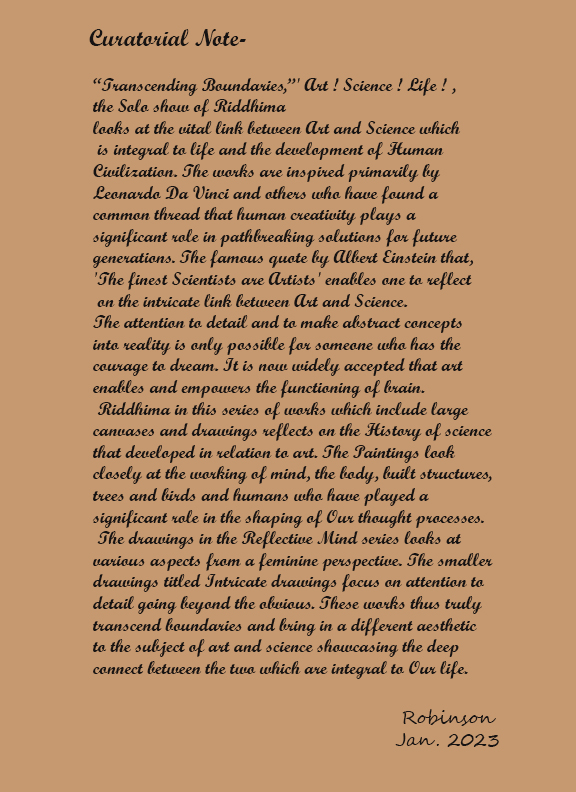
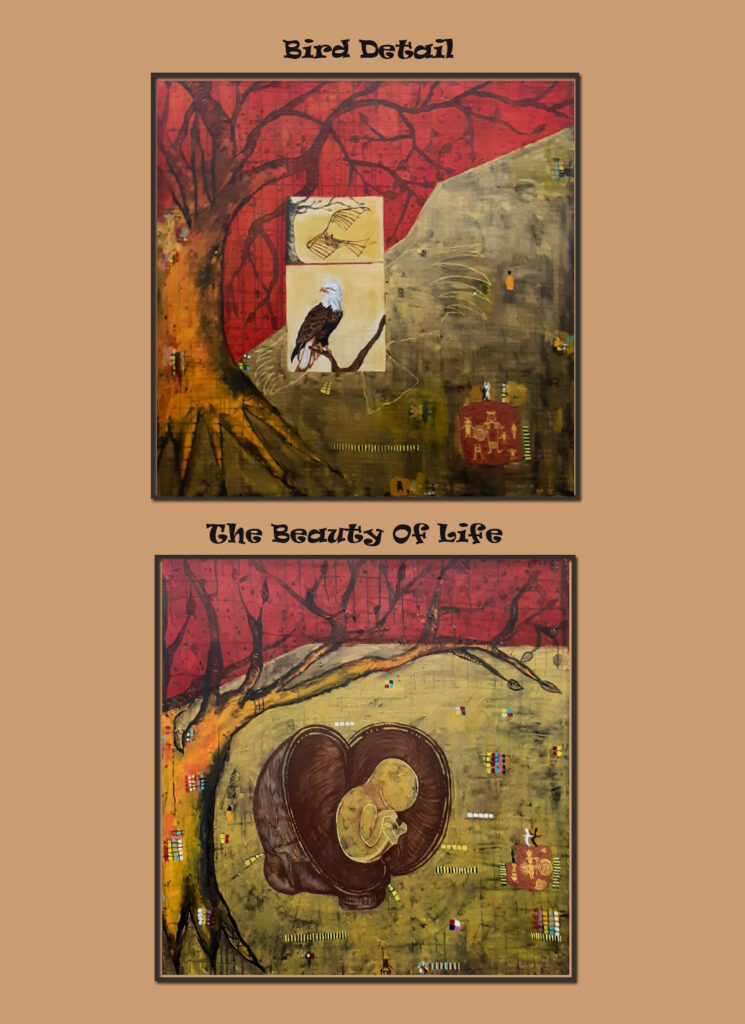
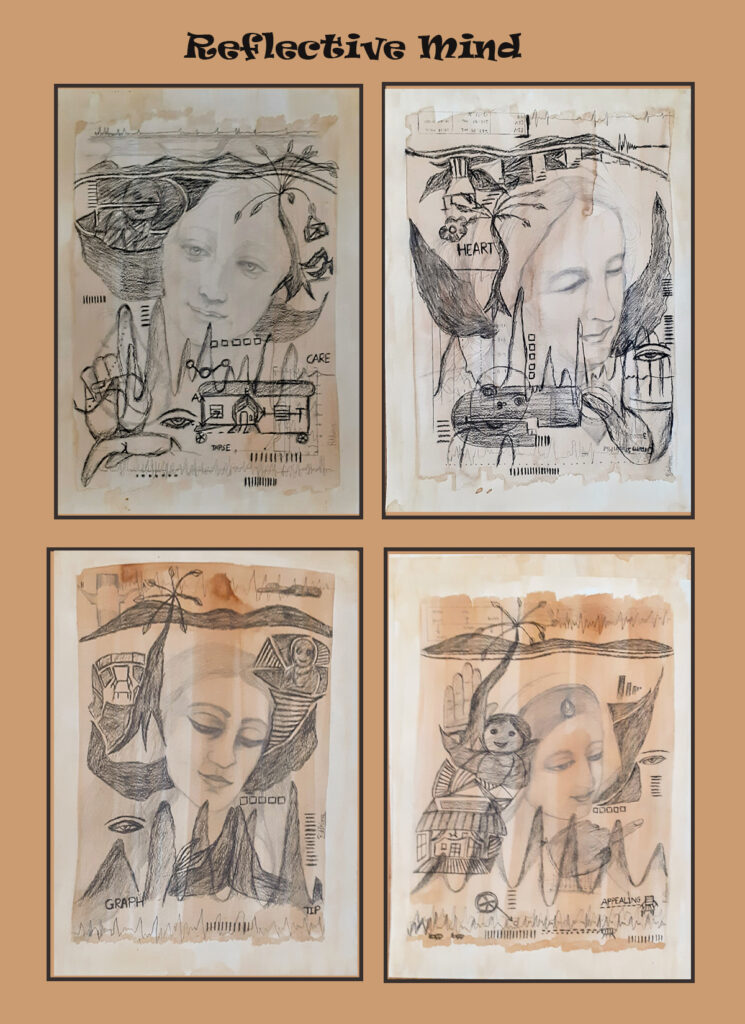
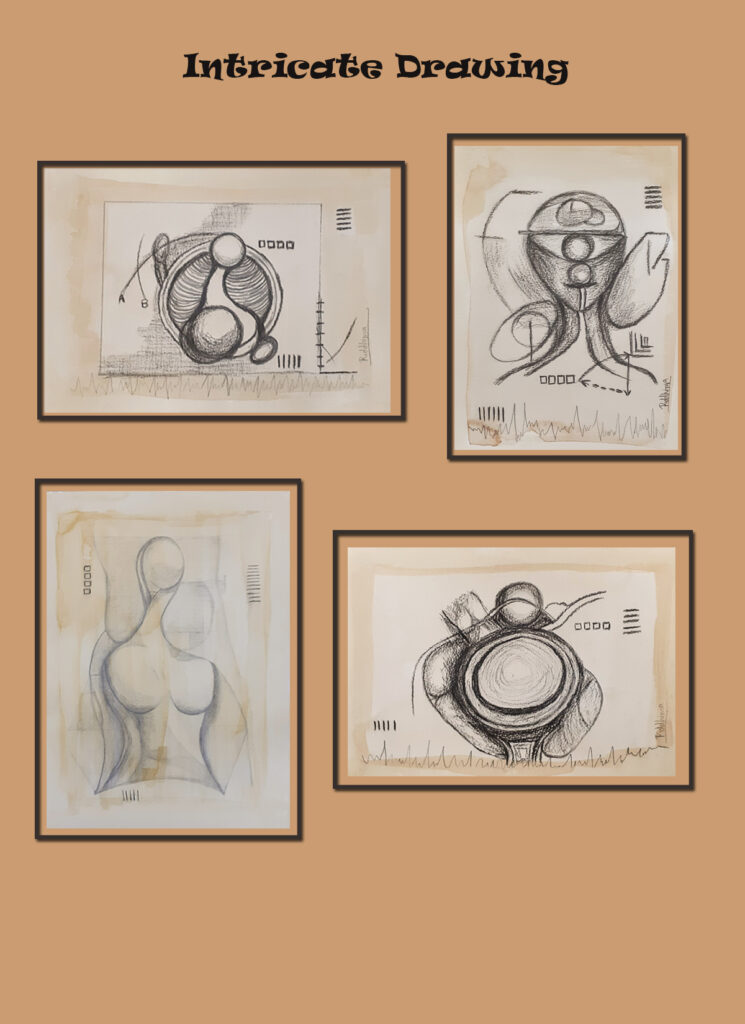
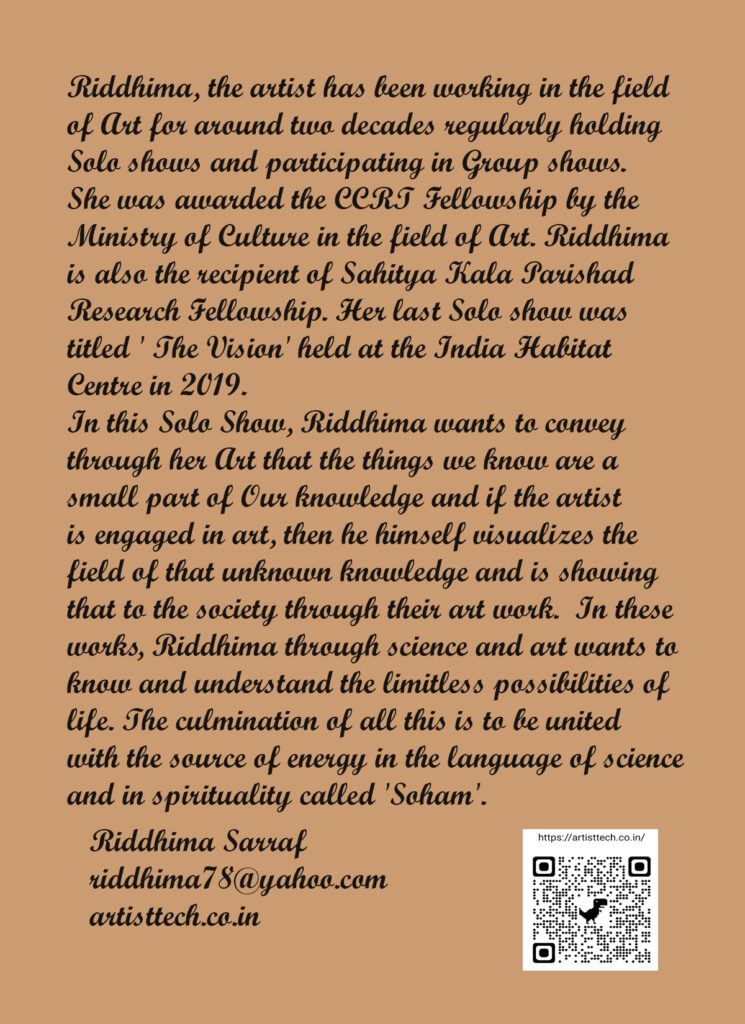
An artist by nature, an out-of-this-world person,
Even in those things beyond borders,
Something excites these things beyond the horizon,
Know which is the field of ignorance that binds the artist,
By filling the paintbrush, the color engraves these pictures,
Some figures that do not belong to this place,
Ahh! You can call it a lie too,
because you don’t even know it,
Hey even the artist doesn’t know
In this world of dreams,
The artist takes you on a tour of a new world,
Yes, he is an artist who can paint feelings,
from senses to knowledge,
And makes life fragrant with knowledge….
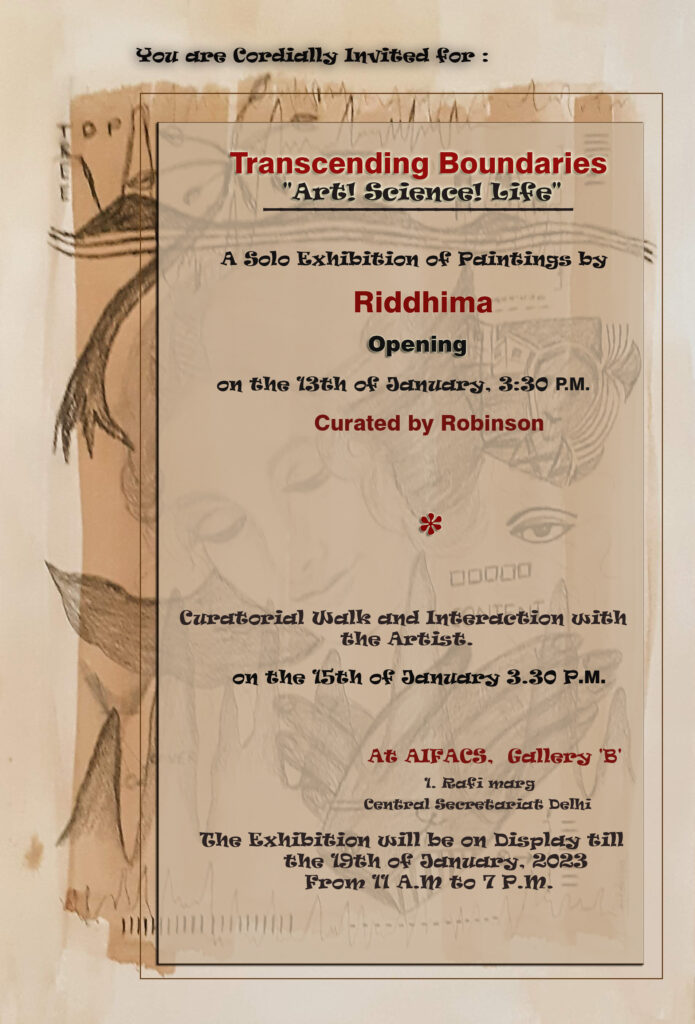
सीमाओं के पार
स्वभाव से ही एक कलाकार इस दुनिया से बाहर का व्यक्ति,
उसमें भी सीमाओं के पार की बातें,
कुछ उत्साहित करती हैं ये क्षितिज से पार की बातें,
जाने कौन सा वह अज्ञान क्षेत्र है जो कलाकार को बांधता है,
तूलिका में भरकर रंग इन चित्रों को उकेरता है,
कुछ आकृतियाँ जो इस जहाँ की है ही नहीं,
आह ! कह सकते हैं आप इसे झूट भी,
क्योंकि आप इसे जानते ही नहीं,
अरे कलाकार भी नहीं जानता,
स्वपनिल इस संसार में,
आपको कलाकार एक नए संसार की सैर कराता है,
जी कलाकार है यह जो रंगो से सवेंदनाओं को,
संवेदनाओं से ज्ञान को,
और ज्ञान से जीवन को महकाता है….
Geeta Nitypaath
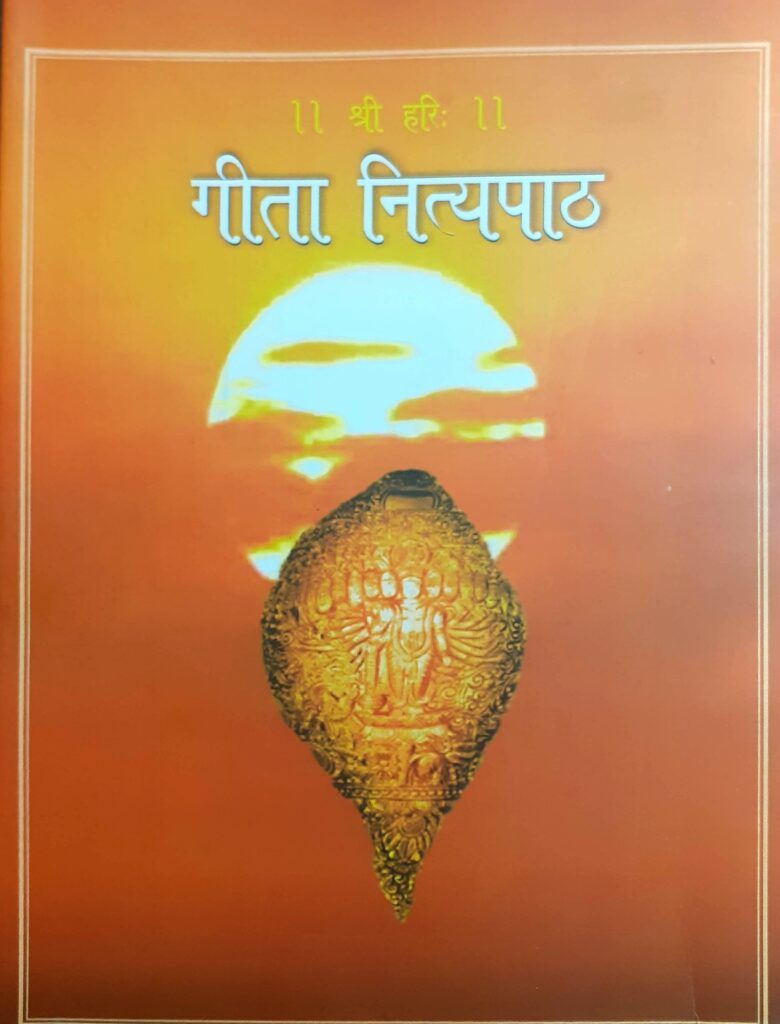
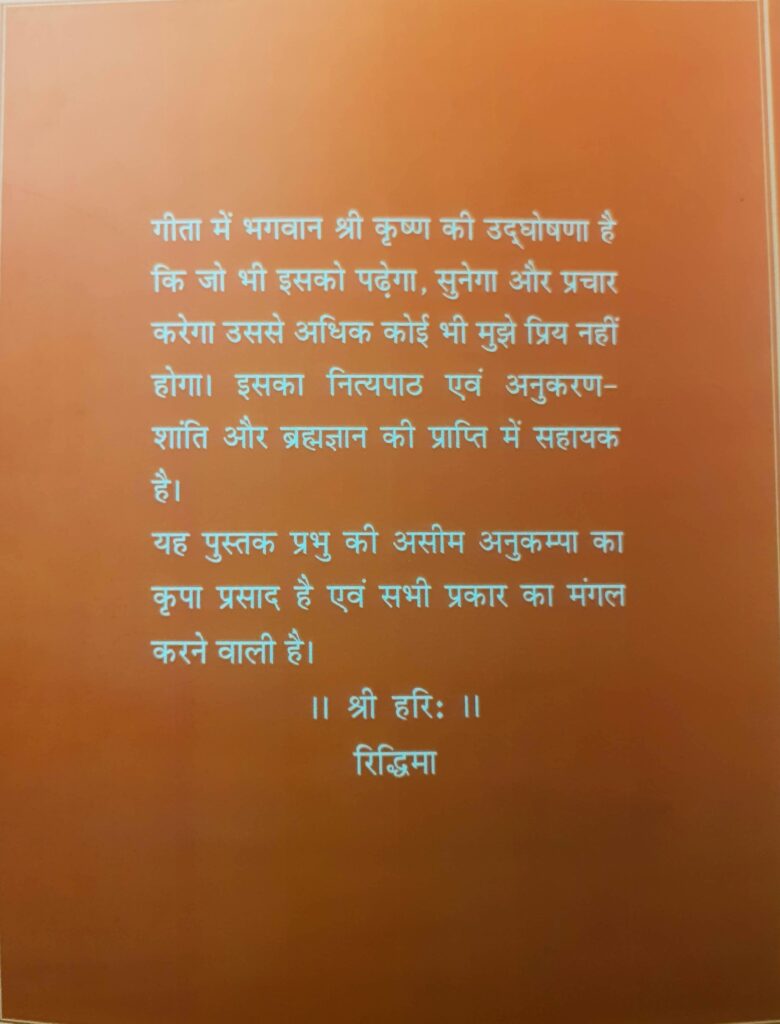
Confluence of Traditional and Contemporary
art of India, Need, Importance
http://www.ijirset.com/upload/2022/june/79_Confluence_NC.pdfhttp://www.ijirset.com/upload/2022/june/79_Confluence_NC.pdf
Art is like a horizon that has no end. It is so vast, so wide that it contains many genres in itself, only then did the poet’s
mind said-
‘Sahitya, sangeetah, kala viheenh, sakshat pashuh pukshchh vishaanheenh’
‘Literary Music Artless man is like true animals without tail’
Art is the most important of all efforts made by humans to attain happiness and knowledge.
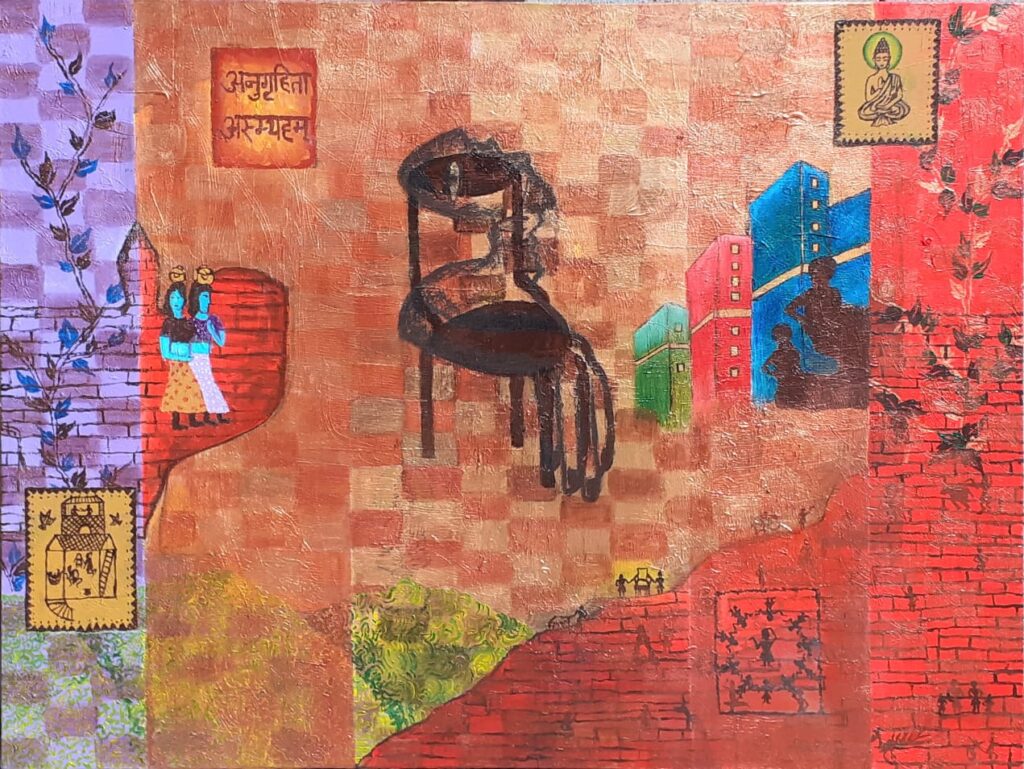
Confluence of traditional and contemporary art – 2
ABSTRACT: During my various art writings, when I studied deeply the works of Ramkinkar Baij, Nandlal Basu,
Picasso, Henry Moore, and other eminent artists, I found that in these entire artist’s great artworks, there is the
contribution of traditional and tribal arts. Without becoming proficient in the arts that we inherit from tradition; when
we start diving in the ocean of modern art, then somewhere our art skills are left behind. Many times the artist himself
does not even know by which process he can make his artwork more impressive, so this article can give a vision to all
those students and artists also. Apart from all this, it is also my interest to do an in-depth study on this subject to
understand this topic more firmly because we cannot deny the importance of traditional art in the culture of a country,
but in such a situation contemporary art also serves to connect global cultures. Therefore, contemporary art frees an
artist from the shackles of time and space and elevates him to the heights of spirituality, making it even more important
for the artist to understand both.
At the same time, I see its separation from traditional art as the reason why contemporary art does not reach the hearts
of ordinary people. Thus because of realizing its importance from different aspects, I decided to write and create many
works of art on this subject.
KEYWORD(S): Visual Arts, Indian Traditional Art, Contemporary Arts, Art and Culture, Art Education
I. INTRODUCTION
This paper is discussing the combination and confluence of elements of contemporary art and various Indian arts. This
paper shows the need and importance of contemporary art along with the importance of tribal art in the Indian social
and cultural environment.
The art is carrier of Stya, Shiva, and Sundara, has importance in many ways in life. It makes us feel the fragrance of life
in the mechanical world and it is successful in giving that pleasure so that you can easily enter that unconscious mind
which is elaborately explained by the name of quantum physics or quantum mechanics.
Here we will go into a brief about the overall artistic history of India, which I have come to know through my academic
study of art so far; it is hardly possible to read it so comprehensively anywhere else. This will not only help you to
understand the artistic richness of India but perhaps also know how contemporary art has made its place in the world.
This paper also includes the Indian dimensions of the drawings of art.
II. ACCORDING TO INDIAN SCRIPTURES, THE RULES OF PAINTING
In the Natyashastra Bharata Muni clarified that “there is no such knowledge, no craft, no discipline, which is not art.”
“Art is a means of expressing the primordial being.” – Hegel
A complete scientific explanation of art and beauty has been given by Indians in Vedic culture as well; Like the human
body, how many Taal (measures) are there in the body of a woman and man, what aspects make the picture observable
in combination with an ideal picture, and the colour combination and their effects have been explained in an elemental
way. Be it the Khajuraho sculpture or the Iron Pillar of the Qutub complex; India is considered a leader in the world in
terms of technical and ancient architecture.
In Vishnudharmottara Purana about painting artworks written –
Kalanam Pravaram Chitram Dharmarth Kaam Mokshadam,
Mangalya Pratham Dotad Grihe Yatra Pratishtam.
That is, painting is the highest of the arts in which Dharma, Artha, Kama, and Moksha are attained. Therefore, the
presence of auspicious is always considered in the house where the prestige of the pictures is high. Yashodhar Pandit in
his book Jayamangala has given a detailed discussion of the six limbs of art so that you can paint a picture as a
complete picture. This is a unique measure in the Indian art world that no one can deny.
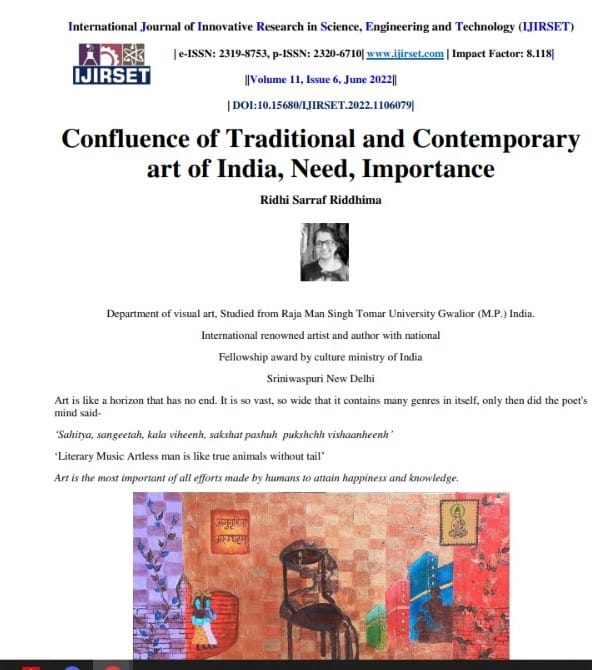
अजंता भाग १
अजंता भाग १
आज मैं आपको भारत के चित्रकारी के ह्रदय से मिलाने का प्रयास करने वाली हूँ,
क्या आप अनुमान लगा सकते हैं,
शायद सभी समझ गये होंगे कि मैं किसकी बात कर रही हूँ।
जी- मैं बात कर रही हूँ अजंता की अप्रतिम अपरिहार्य एवम् अपने युग की अविस्मरणीय चित्रकारी की।
इनकी चित्रकारी को समझने के लिए हमें सूक्ष्म में भगवान बुद्ध का जीवन परिचय जान लेना चाहिए, इससे न केवल हम गहराई से इसके महत्व को समझ पायेंगे बल्कि विद्यार्थी आसानी से इनकी चित्रकारी के नाम भी याद कर पायेंगे। मैं कहानी के साथ जो मुझे स्मरण में आ रहे हैं उन सभी चित्रों के नाम भी अंकित करती जाऊँगी और एक बार पुनः जब उनको गुफाओं के नंबर के साथ दोहराऊंगी तो आपको ये नाम आसानी से याद हो जायेंगे। इसके अलावा आपको अन्य भी रोचक प्रश्नों के उत्तर मिलते जायेंगे अतः आप इस ब्लॉग को पूरा पढ़ें –
भगवान् बुद्ध जिनका वास्तविक नाम सिद्धार्थ था एवं वे राजा शुद्धोधन के पुत्र थे। उनकी जन्म देने वाली माँ – मायादेवी थीं एक दिन जब बुद्ध गर्भ में थे तो उन्हें स्वप्न में कमल के दर्शन हुए ( मायादेवी का स्वप्न (चित्र )), सिद्धार्थ को जन्म देने के बाद संभवतः ७ दिनों में उनका स्वर्गवास हो गया तथा सिद्धार्थ का पालन पोषण उनकी बहन प्रजापति गौतमी ने किया था -जो कि उनकी दत्तक माँ भी थीं एवं बुद्ध के संघ में प्रवेश करने वाली वे प्रथम महिला थीं। जिनसे राजा शुद्धोधन को एक अन्य पुत्र प्राप्त हुआ जिनका नाम नन्द था जिनके अनेक चित्र – नन्द तथा सुंदरी की कथा , नन्द की दीक्षा , नन्द का वैराग्य – भिक्षु होना आदि प्राप्त होते हैं। सिद्धार्थ लुम्बनी में पैदा हुए थे। इनके जन्म के समय ही शाक्त मुनि ने इनके सन्यासी होने की भविष्यवाणी की थी। राजा ने इस डर से इन्हें अत्यधिक ऐशो आराम में रखा एवं पढाई पूरी होते ही इनका विवाह यशोधरा के साथ कर दिया (इनके विवाह में उस समय की सर्वश्रेष्ठ सुंदरी एवं वैशाली की नगर वधु आम्रपाली भी आई थी जो कि बाद में भिक्षुणी बन गई थी साथ ही मगध नरेश बिंबसार जिनका पुत्र अजातशत्रु था जो कि अत्यधिक क्रूर राजा था – इससे संबधित चित्र हैं – अजातशत्रु और बुद्ध की भेंट एवं अजातशत्रु की पत्नी) भी आये थे।
एवं यशोधरा से इन्हें राहुल नाम का पुत्र प्राप्त हुआ। लेकिन शुरू से ही इनका वैरागी एवं अहिंसक मन संसार के दुःखों को देख कर इतना व्यथित हो गया कि वे प्रत्येक प्राणी के दुःखों को दूर करने के उपाय सोचने लगे , पति की इस पीड़ा से व्यथित यशोधरा को लगा कि यदि वे महल में रहेंगे तो शायद कुछ अनहोनी न हो जाये एवं बुद्ध ने भी आश्वासन दिया कि वे अपने प्रश्नों का उत्तर मिलने पर लौट आयेंगे। यशोधरा के पति के जाने बाद का चित्र मरणासन्न राजकुमारी एवं बुद्ध का गृह त्याग के रूप में चित्रित है।
बुद्ध ने अलार कलाम से दीक्षा ली एवं योग के चरम बिंदुओं को पाया लेकिन फिर भी प्रश्न बाकी थे तो उन्होंने विचार किया कि जब तक उन्हें उनके प्रश्नों के उत्तर नहीं मिलेंगे वे अन्न ग्रहण नहीं करेंगे , वे वैट वृक्ष के नीचे ध्यान में स्थित थे – तभी वहाँ सुजाता नाम की स्त्री आई – उसे लगा कि वृक्षदेवता ही मानो पूजा लेने के लिए शरीर धरकर बैठे हैं। सुजाता ने बड़े आदर से सिद्धार्थ को खीर भेंट की और कहा- ‘जैसे मेरी मनोकामना पूरी हुई, उसी तरह आपकी भी हो।’ इस घटना से संबधित चित्र है सुजाता की खीर।
उसी रात को ध्यान लगाने पर सिद्धार्थ की साधना सफल हुई। उसे सच्चा बोध हुआ, तभी से वे ‘बुद्ध’ कहलाए। जिस वृक्ष के नीचे सिद्धार्थ को बोध प्राप्त हुआ, उसका नाम है बोधिवृक्ष (पीपल का पेड़ ) है और जिस स्थान की यह घटना है, वह है बोधगया।
हाँ बीच में साधना के अंतर्गत कामदेव पर विजय ( मार विजय ), पूर्व जन्म कथाएं ( छ्दंत जातक, हस्ती जातक , महाहंसजातक , चीटियों के पहाड़ पर सांप की तपस्या आदि पूर्व जन्म के चित्र हैं जिन्हें जातक कथाओं के नाम से जाना जाता है ) आदि विभिन्न प्रकरण भी उनके जीवन में घटित हुए।
बोध प्राप्त होने के बाद – आषाढ़ की पूर्णिमा को भगवान बुद्ध काशी के पास मृगदाव वर्तमान में जिसे सारनाथ कहते हैं – वहीं पर उन्होंने सबसे पहला धर्मोपदेश दिया। भगवान बुद्ध ने मध्यम मार्ग अपनाने के लिए लोगों से कहा। दुःख, उसके कारण और निवारण के लिए अष्टांगिक मार्ग सुझाया। अहिंसा पर बड़ा जोर दिया। यज्ञ और पशु-बलि की निंदा की।
80 वर्ष की उम्र तक भगवान बुद्ध ने धर्म का सीधी-सरल लोकभाषा – पाली में प्रचार किया। उनकी सच्ची-सीधी बातें जनमानस को स्पर्श करती थीं। लोग आकर उनसे दीक्षा लेने लगे। यहाँ अँगुलीमार एवं अजातशत्रु जैसे क्रूर लोगों के ह्रदय परिवर्तन की कथा प्रचलित है। यहां सम्राट अशोक का नाम भी उल्लेखनीय है जो कि मौर्य वंशके महान शासक – चन्द्रगुप्त के पौत्र थे एवं कलिंग युद्ध के पश्चात उन्होंने बौद्ध धर्म अपना लिया था एवं विभिन्न एशियाई देशों में ८४००० स्तूपों का निर्माण करवाया। इनके पुत्र महेन्द्र, एवं पुत्री संघमित्रा का नाम भी बौद्ध धर्म के प्रचार में उल्लेखनीय स्थान रखता है।
अब हम बीच में जो कहानी अधूरी रह गई उसे पूरा करते हैं – ज्ञान प्राप्त करने के बाद बुद्ध लुम्बनी जाते हैं , एवं जिस नगर के लोगों को वो दान दिया करते थे – आज वो वहां भिक्षा मांगते हैं -( राज गृह की गलियों में भिक्षा पात्र लिए बुद्ध ) , पिता नाराज़ भी हैं और इस विचार में भी हैं कि शायद अब यह लौट आये , बुद्ध के पुत्र राहुल नौ वर्ष के हो चुके थे व अपनी माता से पिता की वीरता एवं महानता के विषय में सुनते रहते थे , अब सिद्धार्थ – बुद्ध के रूप में प्रेम का रूप हो चुके थे, सभी के प्रति प्रेम रखने वाले बुद्ध ने पुत्र को ह्रदय से लगाया।
यशोधरा बुद्ध की पत्नी थीं वे जान गई थीं अब वे सूर्य का प्रकाश बन चुके हैं जिस प्रकाश पर सारे विश्व का अधिकार है, बुद्ध ने जब अपना भिक्षा पात्र आगे किया तो यशोधरा ने राहुल का समर्पण कर दिया , क्योंकि इससे कम और अधिक वह देती भी क्या , सम्बंधित चित्र – माता पुत्र जिसे राहुल समर्पण के नाम से भी जानते हैं जो कि अजंता के पद्मपाणि के बाद दूसरा सबसे प्रसिद्ध चित्र है।
अस्सी वर्षों तक धर्मोपदेश देने के बाद उनका महानिर्वाण कुशीनगर नामक स्थान पर हुआ।
तो ये थी भगवान् बुद्ध की कहानी क्योंकि इनके जन्म से लेकर कोई भी घटना क्रम नेट व अन्य प्रश्नपत्रों में पूछा जा सकता है तो इसलिए मैंने विद्यार्थियों की एवं पाठकों की रूचि के लिए सम्पूर्ण वृतांत को सीमित कर बताने का प्रयास किया है।
अभी क्यूंकि यह विषय काफी विस्तृत है इसलिए मुख्य बिंदुओं के साथ हम इसकी चर्चा अगले भाग में करेंगे।
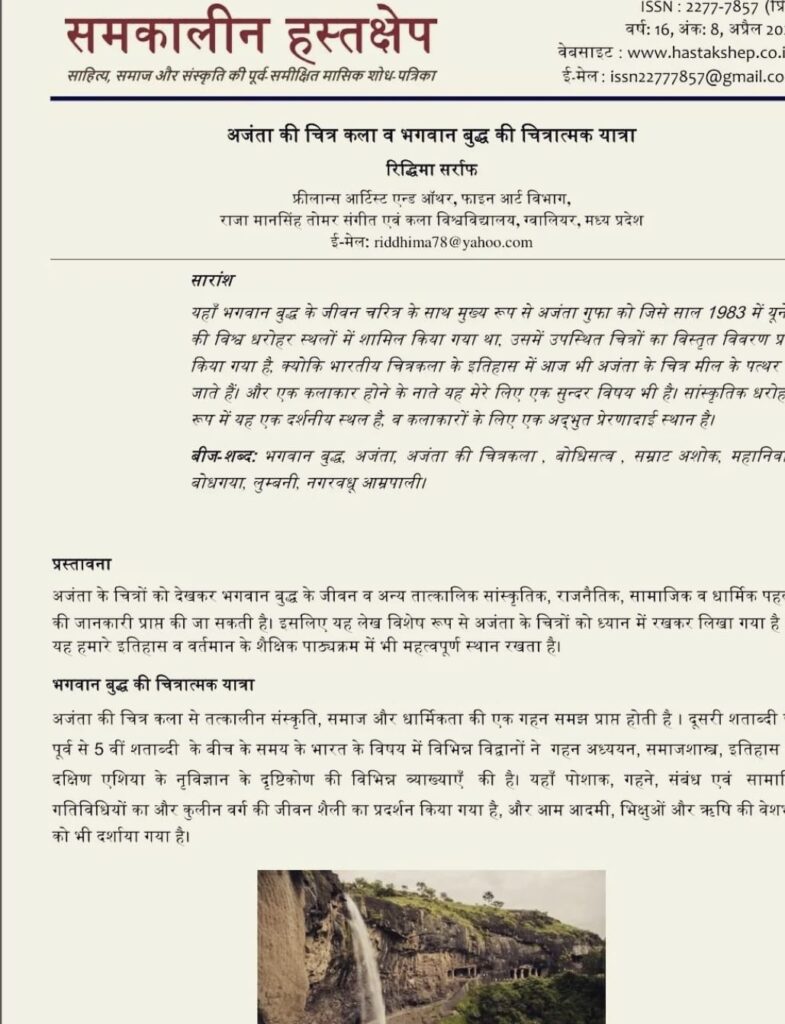
https://art.artisttech.chttps://art.artisttech.co.in/o.in/2021/10/blog-post_14.html
Sigmund Freud’s Journey from ‘Libido’ Theory to the ‘Unconscious’ Theory in Art
..
link –


Author Ridhi Sarraf Riddhima
International renowned artist and awarded with fellowship by culture ministry of India
From time to time all art and aesthetics reflect the current intellectual trends of their time.
Sigmund Freud of Austria, a revolutionary, the great physician of the human mind, the founder of psychoanalysis, was not only a neurologist, psychiatrist, but also a philosopher, writer, poet. In short, he did not leave any subject untouched. Sigmund Freud discussed psychoanalysis as a way to deal with psychopaths and as an intellectual discipline.
A kind of upheaval or revolution of ideas was by Sigmund Freud a medical man who founded the science of psychoanalysis. Psychoanalysis initially emerged as a technique to treat mental illness, which was related to mental diseases. Then Freud tried to probe deeper into the unknown realm of the unconscious and was successful in this. Freud also conducted psychoanalytic studies on art and thus attempted to find unconscious factors within the artist’s own psyche.
A famous conception about Freud’s theory-
Freud’s theory – libido is often defined only in relation to amorousness. But this theory of Freud is much broader and deeper than this. This energy generally discusses the subject of the corporeal, but it also analyzes other diverse and broader states of mind. According to them, a large part of our brain is unconscious. He explained it as saying that mental energy is like a great reservoir; it includes mental impulses, primitive emotions and desires and felt pain etc.
Freud’s ideas about art seem like sensuality. But he interpreted both art and dreams as expressions of desires powerfully active in the unconscious. According to him, art is the fulfilment of man’s insatiable desires. Freud’s aesthetic theory presented such subjective and discordant theory.
But his discovery was so important that not only it did transform psychological theory, but revolutionized the entire intellectual world and post-Freud thought was not as before.
Before understanding Freud’s ideas of art, it is necessary to take a look at his other psychoanalytic aspects as well –
Oedipus and Narcissus Doctrine –
The heroes of Greek myths have been fascinating to psychoanalysts, who regard them as symbols of human intrapsychic life, development and conflicts. Many of these gods and heroes, such as Oedipus, Electra, Eros and Narcissus, have been named after psychological conditions, conflicts, and illnesses. Freud chose the myth of Narcissus to symbolize a self-absorbed individual whose libido is invested in the ego rather than in other people. The term narcissistic personality disorder, also derived from myth, describes a self-loving character with grandiose feelings of uniqueness.
His study emphasized the identification of childhood events that can affect the mental function of adults. Genetic and then developmental aspects gave psychological theory its characteristics.
According to Freud, dynamic personality formation and other ideologies –
Freud considered the nature of the mind or personality to be dynamic.
In general, the development of the ability to do a task in a better way is called dynamic development. And it is in gross (cognitive) and subtle (ignorant) form.
According to Freud, the dynamic side of personality is formed by three stages.
1. Id
2. Ego
3. Super ego
According to him personality is the name of the activities of our mind and body. According to Freud, there are some mental elements which are not found in the conscious. In this, desires are related to childhood wishes, sexual desires and mental struggle etc., which are not even known to the person himself. Generally, the person is not able to fulfil them in his day-to-day life and by taking these distorted forms; these desires are present in front of the person in the form of dreams or sudden practical abnormalities.
Id is born with the birth of man. Its themes are desires that are related to libido and want instant gratification.
The ego is considered by Freud as self-consciousness which he described as the secondary control of human behaviour. It is the organized part of the Id, its purpose is to further the goals of the Id.
Para ego is a kind of standard of behaviour, which reflects moral behaviour. It develops over a period of time. Freud’s ideas of personality are also called the theory of psychosexual development. Freud has divided it into 5 stages –
1. Oral stage – one year from birth
2. Anal stage – 2 to 3 years
3. Phallic stage – 4 to 5 years
4. Latency stage – 6 to 12 years
5 Genital stages – 12 to 20 years
On the basis of the above theory, he gave the concept of Electra and Oedipus, which is a very complicated and controversial theory. According to him many qualities and characteristics of the lower animals are seen in man. And here in this theory he has tried to define attraction towards opposite sex.
According to him, only 1/8 part of the brain is conscious; the rest 7/8 part is unconscious. Many times in our life, we find this unconscious state when suddenly some social concepts break. Dreams, daydreams, slip of the tongue and small or major lapses of memory are other manifestations of the unconscious.
According to Freud, a work of art emanates from the three levels of the mind. Freud’s art theory is a dynamic theory and is full of energy, and he describes the artist as a creator or reservoir.
Here we will mainly explain his ideas about beauty or art.
Freud’s discussion on poetry, art and beauty –
Although Freud never presented a very mature and complete idea of art, yet we can know his ideas from his various essays, books and lectures.
Some of his works –
Leonardo da Vinci,
The Interpretation of Dreams,
The Relation of Poet to Daydreaming,
Wish Fulfilment and the Unconscious,
On Creativity and the Unconscious: Papers of the Psychology of Art, Literature, and Religion
According to him, if the part of our brain remains insatiable or in repression, then it never ends. That is, those unsatisfied desires remain buried somewhere and those desires constantly struggle to come out. But these are stopped by the ego which appears as a reflection of the outside world. Those desires are seeking pleasure, yes they are not satisfied at the level at which they initially appeared as instincts.
Some of the ways that one presents the gratification of this unconscious desire are –
Anna Freud who was Freud’s daughter, herself has discussed these main defence mechanisms. Because through these the ego can block itself from external reflections and can also satisfy its unconscious desires. These brain resources are also unconscious.
His thoughts regarding art and the artist pass through the unconscious mind. Actually, therefore, first in short we have to know the explanation of these brain resources also.
Some of these are as follows –
Repression: suppression means to completely stop or restrict those impulses which are not acceptable in the outside world. As we often find, in religious places saying a person that he is completely pure and he does not have such dirty thoughts thus he suppresses many of his physical and mental desires.
Opposite: means to turn an unwanted desire into an opposite desire, such as hate with love. As it happen in the case with real brothers.
Turning towards oneself: In this the person loves or hates himself. The above mentioned narcissism is an example of love and masochism is an example of hate.
Displacement: This is also an important mechanism in which the place of one object is taken by another object. As some people themselves are suffering from the trouble they demand justice or agitate against it in the society.
Neurotic Symptoms: He has elaborated on hysteria or other imaginary diseases. According to him, all these are the result of our repressed feelings.
Up gradation: This is an advanced and socially supported dimension. This sublimation process includes art, poetry, religion etc. Freud told that this is also the form of our repressed desires but it is presented in a different way.
Freud has described in detail about Leonardo, Novelist Dostoevsky and the religious man Moses. According to Freud, the artist’s subjects are influenced by his early life. Such as the works of Leonardo –
Infantile Fantasies of Vulture.
Fantasy about female figure – Her Mother.
Monalisa – Represents her mother’s smile.
Revival of Childhood – Revival of Childhood through Colour, lines and structure.
Madonna – Mother is glorified as a portrait in art.
His Abnormal Desire to Look – A Glimpse of Childhood
For Freud, art is a symbolic summary of unconscious desires.
Here comes the theory of dreams because dreams are the workshop of symbols.
Dream and art –
Dreams are mental actions that seem meaningless but are never meaningless. They are fulfilling our desires in another way. According to him, unsatisfied desires take the form of dreams to manifest in sleep. First of all, big desires take a small form, then they manifest in a perverted form in dreams. As if anger or aggression is in the form of a knife or a pistol. The dream acts like a personal hidden symbolic code. Dreams have a symbolic construction. And similarly this symbol is cited in the form of fairy tale, folk song or poetry.
According to Freud, the creation of dreams or art is identical. In both there is a journey beyond daily life.
There are some differences between art and dream – that art is an act done consciously or in the knowledge, whereas dream is not.
Art is tied to the medium whereas the dream is not.
In art, there is variety in pictures, whereas dreams are of a strange kind.
The individual desires of the artist take the form of an art picture or figure and they are also enjoyed by other people, there are also various reasons for this –
As fiction presentation should not be personal it should be universal.
The topic should be of engaging people.
The principle of beauty should be expanded.
According to Freud, art is a kind of reconciliation between the principles of pleasure and mental functioning.
First, Freud collects examples of an infinite number of desires – whether it is about the punishment of Hamlet, or the various works about the only strong memory of Vinci’s mother, or Michelangelo’s work on Moses in all the mental attitudes or constellations are functioning in the same manner.
The art in them act like the most personal dream. The artist not only presents an imitation of the true life, but he rises above all by liberating himself.
Reference: Krishna’s Aesthetics, Prakash Veereshwar
Nupur Sharma, HindiSahitya.com, Arash Javanbakht





